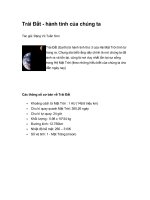VN002_Dat_Mui
Bạn đang xem bản rút gọn của tài liệu. Xem và tải ngay bản đầy đủ của tài liệu tại đây (145.65 KB, 2 trang )
VN002
Dat Mui
Dat Mui
Criteria: A1 & A4i
Province(s):
PA Status:
Ca Mau
Nature Reserve
Latitude:
Longitude:
Area:
Altitude Range:
8º38'N
104º45'E
4,388 ha
0-2 m asl
EBA / SA:
None
Priority Landscape:
None
General Description
This IBA comprises Dat Mui Nature Reserve, which is situated on the Ca Mau peninsula, the southernmost tip of
th
Vietnam. In the first half of the 20 century, the site was covered in natural mangrove forest dominated by
Rhizophora apiculata. However, as a result of the effects of the Second Indochina War and expansion of
aquaculture and agriculture, much of the original mangrove forest was lost. In recent years, most of the aquacultural
ponds have been abandoned, allowing recolonisation by mangrove. Dat Mui also supports extensive, continually
1
accreting mudflats, which are being colonised naturally by mangrove . Dat Mui borders Bai Boi IBA to the north.
Bird Fauna: Key Features
2
Dat Mui IBA is an important staging area for migratory shorebirds, egrets, gulls and terns . Surveys to date have
confirmed the occurrence of six globally threatened and near-threatened bird species at the site. In addition, the site
supports significant concentrations of three congregatory waterbird species: Chinese Egret Egretta eulophotes,
Asian Dowitcher Limnodromus semipalmatus and Eurasian Curlew Numenius arquata. While only one of these
species is currently confirmed to exceed the 1% population threshold required to meet the A4i criteria, taking into
account bird turnover and the limited survey coverage to date, the other two species are also likely to exceed the 1%
1
population threshold . Large concentrations of Whiskered Tern Chlidonias hybridus and Caspian Tern Sterna caspia
have also been recorded at the site, with one single count of the latter species constituting up to 2.1% of the East and
1
South-East Asian population of the nominate subspecies caspia .
Species
IBA
Criteria
Other
IBAs
A1, A4i
Global
Threat
Status
VU
C hinese Egret
Egretta eulophotes
S pot-billed P elican
Pelecanus philippensis
A1
VU
6
F ar Eastern C urlew
Numenius madagascariensis
Asian Dowitcher
Limnodromus semipalmatus
B lack-headed Ibis
Threskiornis melanocephalus
P ainted S tork
Mycteria leucocephala
Eurasian C urlew
Numenius arquata
A1
NT
4
A1, A4i
NT
5
A1
NT
8
A1
NT
10
A4i
6
1
Notes
Nine birds were recorded in M arch 1999 1. A total of83
birds were recorded at this site and B ai Boi IBA in March
2000 3. At least 30 birds were recorded in December 2000 3.
T wenty six birds were observed feeding inshore in
S eptem ber 1993 4. A single individual was recorded in
August 1999 1.
T wo birds were recorded in M arch 1999 and one in August
1999 1. S ix birds were recorded in Decem ber 2000 3.
A m axim um count of 144 birds was made in August 19991.
T he site probably m eets the 1% threshold for this species.
'S ubstantial num bers' were recorded in August 19991. At
least 30 individuals were recorded in Decem ber 2000 3.
'S ubstantial num bers' were recorded in August 1999 1.
A m axim um count of 322 birds was made in August 19991.
T he site probably m eets the 1% threshold for this species.
Biome Restricted Species: The site does not qualify under criterion A3. See Appendix 4 for details.
Directory of Important Bird Areas in Vietnam 49
VN002
Dat Mui
Secondary Criteria
The site does not qualify under any secondary criterion.
Threats to Biodiversity
The mangrove forests of Dat Mui have been severely degraded in the last 10 years, largely as a result of of illegal
encroachment and conversion to aquacultural ponds. Considerable effort has been made to restore the site and many
illegal settlers have been evicted. However, there are substantial numbers of people living in or around the site, who
1
frequently encroach it and exploit the remaining mangrove . In addition, illegal fishing, which has been documented
3
as being widespread at the site, is thought to cause significant disturbance to the avifauna . If unregulated, this
activity could also potentially lead to declines in abundance
3
Severity
of local marine life . The largest potential threat to Threat
Afforestation
● ● ●
biodiversity at Dat Mui is afforestation of the intertidal
Aquaculture/ fisheries
● ●
mudflats with mangrove or of areas of disused agricultural
Disturbance to birds
● ●
land (which is also an important habitat for migratory birds) Natural events
● ●
with tree species.
S elective logging/ cutting
● ●
Conservation Actions
•
2
Since 1999, the national 661 Programme has provided budgetary support to Dat Mui Nature Reserve .
Recom m endations
•
•
•
•
•
•
•
•
Dat Mui should be combined with Bai Boi Coastal Protection Forest as a single protected area, which should be
1,3
nominated as a Ramsar site .
1,3
Dat Mui should be nominated under the East Asian-Australasian Shorebird Network .
The boundaries of the nature reserve should be clearly demarked so that local people are aware of its presence
1,3
and nature reserve staff can manage it accordingly .
1
Human activities at the site should be strictly controlled to minimise disturbance to migratory waterbirds .
No afforestation should be carried out on accreting mudflats or disused agricultural land, as these provide
1,3
important habitats for migratory waterbirds .
1
No further development of aquaculture should be permitted within the boundaries of the nature reserve .
Awareness-raising activities should be conducted among local communities to promote understanding of the
importance and fragility of the biodiversity of the site and stimulate interest and motivation towards sustainable
3
use of local natural resources .
3
The potential for ecotourism at the site should be investigated .
References
1. Buckton, S. T., Nguyen Cu, Nguyen Duc Tu and Ha Quy Quynh (1999) The conservation of key wetland sites in
the Mekong Delta. Hanoi: BirdLife International Vietnam Programme.
2. BirdLife International and the Forest Inventory and Planning Institute (2001) Sourcebook of existing and
proposed protected areas in Vietnam. Hanoi, Vietnam: BirdLife International Vietnam Programme and the
Forest Inventory and Planning Institute.
3. Moores, N. and Nguyen Phuc Bao Hoa (2001) Vietnam Mekong shorebird site survey 2000. Unpublished report
to Wetlands International Asia-Pacific and Can Tho University.
4. Eames, J. C. and Tordoff, A. W. (in prep.) Recent records and a conservation status review of some threatened
and near-threatened bird species in Vietnam.
50
Directory of Important Bird Areas in Vietnam









